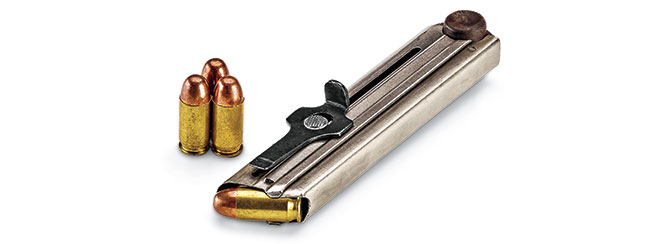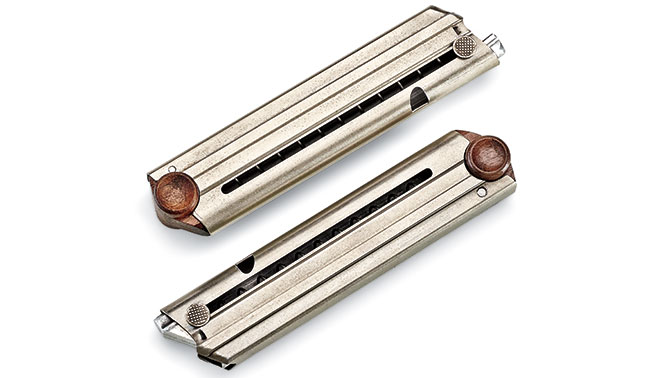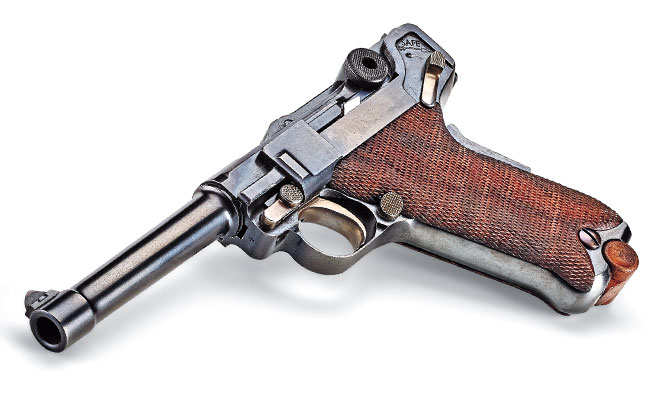A Luger in .45 ACP | Guns & Ammo
A Luger in .45 ACP
Patrick Sweeney April 25th, 2018
Based on the original 1907 design, Lugers in .45 ACP are now available from Lugerman.com. $6,975
There are things you read and think, I’ll never get to do that. Such as drive 200 miles per hour in a race car; date a supermodel; or perhaps shoot a rare and historically significant firearm. For me, I recently checked one of those three off my bucket list.
Back in the first decade of the 20th century, the U.S. Army was playing catch-up. It had finally gotten a modern service rifle in the M1903 Springfield and was in the process of selecting a new service sidearm. The U.S. wouldn’t be up to the rest of the world in machine guns until after the Great War, but in that first decade machine guns were still not seen as something other than light artillery. The U.S. Cavalry, however, wanted a new sidearm, and they, by God, were going to get one in .45 — even if they had to cook the books to get it.
This is why Georg Luger made a pistol in .45 ACP. (Well, five or six of them, if we can believe the records.) One was tested to destruction, one was retained by the U.S. War Department (whereabouts unknown), and the others were left in Germany. Apparently, one or two were found in Germany at the end of World War II and ended up in the hands of collectors.
To call ownership of an original .45 Luger as something to be desired is to damn desire with faint praise.
Ownership was so sought that one pistolsmith of note, John Martz, made Lugers in .45 ACP. This was not without problems, as the process involved taking two 9mm Lugers, cutting them into halves, welding them together, and then refitting the needed parts — many made from scratch — to create a Luger for .45 ACP.
Time-consuming? Obviously. Expensive? $3,000 — in 1979.
Meet Lugerman There is now a source for .45-caliber Lugers who won’t cut up a bring-back. Eugene Golubtsov, also know as “Lugerman”, has commenced production of not just one, but three models of the .45 ACP Luger: U.S. Army Trials Standard Size (an exact replica of the 1907 trials pistol); a compact Commander or “Baby” 1907; and a heavy-barrel target model. The one sent to Guns & Ammo for evaluation was a Standard model, serial number 4.
How has he done this, you ask?
The first step was he had to lay hands on copies of the blueprints of the original Luger developed for the 1907 U.S. Army trials. While quite a feat in itself, the next steps were terrifying from my point of view. Golubtsov had to reconcile the dimensions of a metric-based pistol designed at a time when hand labor was cheap and steel was expensive with modern CNC manufacturing. Adding to the challenge was that dimensions were not measured by the U.S. Army test board.
The amount of hand-fitting that would have been considered normal back then in Germany would bring a modern production engineer to tears. Still, Golubtsov pressed on.
They machined the parts of the .45 Luger out of billets of 4140 steel. The magazines — always a critical part of a self-loading pistol — are made out of 1095 spring steel and hardened after they have been formed.
Then there are the easy parts to manufacturing, such as assembling, testing, bluing, straw-heating the small parts and debugging.
First Impressions The first clue that there is something up about the pistol is readily noticeable when you pick it up. It is a handful, and clearly not the usual Luger.
The frame had to be larger, to accommodate the cartridge and the larger magazine. The barrel is larger in diameter, and everything else is proportioned to accept the cartridge. In photos, it looks like other Lugers but with a different trigger. However, in your hands, it is something else. Yet, the Standard model weighs 4 ounces less than a M1911A1.
Just like the 1907 trials pistol, Lugerman’s .45 has a grip safety. If there is one thing John M. Browning could have done better for the 1911, it would have been to put one like this on his pistol. The safety is back to safe, and so-noted in English. Other than that, everything else is exactly as you’d expect from a Luger — and then some.

Due to the snappy cycling time, the magazine springs are more robust. Without the supplied loading tool, you would be hard pressed to get more than three rounds into this Luger’s magazine.
Since the .45 is heavier than the 9mm, the Luger has a pretty snappy cycling time and the magazine springs are quite stout to keep up. The Lugerman 1907 arrived with a magazine loading tool used to get more than two or three rounds into the .45-caliber Luger’s magazine. I talked with Golubtsov about it, and he agreed that the original design, while being period-correct, needs improvement.
“We’re working on one that is a lot more useful,” he said. “It just isn’t the original design.”
If you are an originalist, then stick with the tool supplied. If not, when Golubtsov comes out with the new one, get it.
Let’s talk ammo. You would think the beefy Luger .45 wouldn’t be picky about ammunition. Think again. Complaining about this pistol being picky (and each one will have different tastes) will not amuse your gun club buddies. (They might even start to talk about you behind your back.)
You will have to accept the fact that when your .45-caliber Luger arrives, should you buy one, you will have to find what load it likes and then buy that. Or you could learn to load your own exactly to the liking of the pistol. Big deal.
After I had spent some time at my gun club testing the Luger .45, I contacted Lugerman. We talked about the project and I apologized for having shot so many rounds through pistol No. 4. I didn’t want to wear down the bluing and make it a problem for the next guy, but according to Golubtsov, the gun sent to G&A had almost 7,000 rounds through it. Seriously?
“We did some testing when it was new, changed a couple of part designs, and then refreshed the rust bluing,” Golubtsov explained. “It has had 6,000 rounds since then.”
So, there you have it. A century-old masterpiece, resurrected and brought into the 21st century.
Oh, one detail that we have learned to improve on since 1907? Today, gun manufacturers make better sights. My sample had sights that were true to the originals, but Golubtsov plans to offer better options for future models including a Luger in 10mm and one with a stock.
All of these handguns can be custom-ordered with the features you want. The starting price is $6,975. Compared to the quote of €10,000 (Euros) I was given by a maker in Germany a few years ago, this is a steal.

Keeping up with convention, Lugerman stayed true to the plans of Luger’s original down to matching the magazines designed for the U.S. Army’s 1907 trials.
You ask, “Why did the U.S. government kick the 1907 Luger to the curb and adopt Browning’s pistol that became the M1911?
Georg Luger couldn’t find a loading in .45 that his pistols liked. The U.S. Army even let him ship in a supply of specially-loaded ammunition just for use in those trials. Even then, it wasn’t as reliable as Browning’s design. Golubtsov and his crew have seemingly solved that problem. And when it comes to ammo, we have an embarrassment of riches. If you want a Luger in .45, you now can get one. If you want to feed it reliable ammo, there are plenty of choices.
Me? I’ve just ticked one more to-do off my bucket list: “Take a Luger .45 to the range.” Yep, I shot that.
Read more: http://www.gunsandammo.com/handguns/a-luger-in-45-acp/#ixzz5F717sbER
